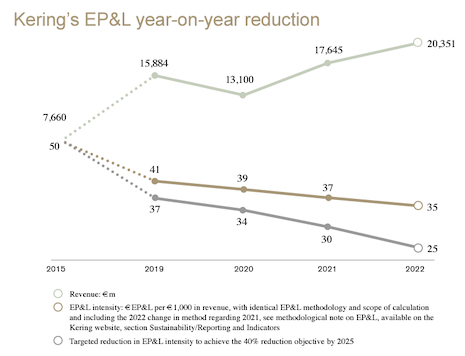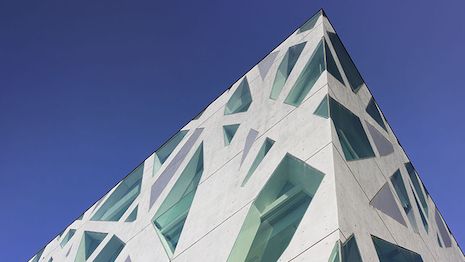French luxury conglomerate Kering is outlining sustainable advancements enacted over the past few years with an update on an inaugural ESG report published three years ago.
Attained four years early in 2021, the group's 40 percent reduction of total environmental impact stands out among a number of milestones highlighted in a new report honing in on 2020-2023. Kering’s research makes clear that today's luxury leaders cannot continue to rely solely on improving current systems — introducing new models of increased efficacy must also play a crucial role.
For the report, Kering measures progress against an Environmental Profit and Loss (EP&L) model, which takes into account impacts covering greenhouse gas emissions, water use, waste, air and water pollution, and land use across the Group’s direct and indirect activities every year.
Climate, collaboration, circularity
Kering's Sustainability Progress Report 2020-2023 revisits a group-wide fur ban (see story), powerful renewable energy policies, major monetary investments in the circular fashion sector and more, all of which have defined the last few years of movement in the space.
The Group’s latest report speaks to the power of approaching ESG targets from all angles, presenting multiple pillars which work towards measurable impact in cohesion. Guiding both the report, and the company's approach, are “care” for the planet, incentives to “collaborate” with people and, finally, pushes to “create” relevant innovations and new business models.
Using Science Based Target initiative (SBTi) input, Kering’s first pillar sets the governance framework from which the group acts.
The French luxury conglomerate's latest report outlined advancements made from 2020-2023
To level set, Kering launched the first major survey of its kind in 2019, analyzing the product use and care habits of more than 3,000 luxury fashion consumers spanning the United Kingdom, Italy, China, the U.S. and Japan. By 2022, the company was able to identify that consumer use phase and end-of-life considerations accounted for 8 percent of its EP&L impact, with the majority coming from ready-to-wear, allowing the conglomerate to develop appropriate interventions aimed at reducing associated impacts.
Tight supplier requirements and detailed mapping efforts are also included as part of this pillar. One subsidiary in particular acts as a case study — the report cites French fashion house Saint Laurent's employment of traceability technology entitled TextileGenesis™, which lends the brand the ability to track raw materials from origin to retail via digital tokens.
When it comes to the “care” pillar, Kering calls out land use as the holding company’s largest area of impact after climate — the former factor accounts for 31 percent of the Group’s EP&L.
Working against a desired net-zero impact on nature by 2025, the report details efforts to improve biodiversity and transform the 1 million hectares of farms that produce raw cotton, wool, cashmere and leather for the firm into regenerative landscapes.
One of the ways the conglomerate has seen this through is by backing The Regenerative Fund for Nature, a finance vehicle benefiting farmers, NGOs and key fashion and luxury stakeholders to engage in regenerative methods such as sequestering carbon, mitigating climate change, restoring nature, improving local community livelihoods and enhancing animal welfare, in 2021.
The fund’s first seven grantees were named in September 2021, and run projects representing 840,000 hectares of land total across South America, Central Asia, India, Europe and Africa. According to the report, these projects directly benefit 60,000 people working in agriculture.
“The Regenerative Fund for Nature is a much-needed catalyst for what is possible — a transformation in the way we use land for agriculture, carbon, biodiversity, and communities,” said M. Sanjayan, Ph.D., CEO of Conservation International, in a statement.
 Kering measures progress against an Environmental Profit and Loss (EP&L) model. Image credit: Kering
Kering measures progress against an Environmental Profit and Loss (EP&L) model. Image credit: Kering
“In South Africa, I’ve seen how this program — and its novel approach to financing — are transforming economies, enriching local communities, protecting biodiversity, and planting the seeds for a global revolution in regenerative agriculture.”
Interestingly, one of Kering’s primary philanthropic pursuits — gender equity — also surfaces in the fight for the planet’s future. The conglomerate considers the empowerment of women across the supply chain to be crucial to progress.
Filed under Kering’s “collaborate” pillar, the report details the manner in which the conglomerate conducted the first-ever study on the role of women across luxury supply chains in Italy.
In a partnership with the National Chamber of Italian Fashion (CNMI), leaders were able to construct a series of e-seminars involving leadership and gender, career development, assertiveness and, lastly, networking and group support based on the initial survey's results, reaching 313 women during 484 separate trainings between 2020 and 2022.
The report adds that last year, Kering joined forces with Bocconi University in Italy to facilitate a student-led ESG challenge, going on to sponsor a specialized certificate in fashion sustainability at The Institut Français de la Mode (IFM) in 2020, available at the Bachelor, Masters and Executive MBA levels.
Perhaps most notable is Kering’s leadership in forming The Fashion Pact.
The coalition of 250 brands working towards climate justice had set more than 14 projects into motion by the end of 2022, including a commitment from the CEOs of 12 member companies to generate 100,000 MWh of solar energy every year, increasing the amount of renewable energy available for purchase.
Forward motion
Simply put, Kering’s third and final category involves a commitment to “create” tomorrow’s climate solutions.
Intentional investments in circular economy players such as Vestiaire Collective, a resale platform in which Kering has taken an approximate 5 percent stake. Bringing circular systems in-house at brands like French fashion house Balenciaga (see story) and Italian fashion house Bottega Veneta furthers the concept.
Eco-friendly design rooted in the use of sustainable, alternative materials on behalf of Kering’s many houses amounts to a large part of this equation as well.
With the knowledge that leather has high environmental costs, an investment in VitroLabs garnered the world's first pilot production of cell-cultivated leather, saving on land use and greenhouse gas emissions. Support for more than 200 sustainability-focused startups like this has extended reach.
“Kering has been an invaluable partner to us over the years,” said Ingvar Helgason, CEO and cofounder of VitroLabs, in a statement.
“They [have been] here since the very beginning and have invested in our product development in such meaningful ways, both with their resources and financially,” he said. “This type of commitment and partnership is exactly what innovations like ours need in order to push forward new frontiers.”
Kering's final pillar loops in engineering and other methods of invention, pointing to an important learning — 50 percent of the company’s emission reduction targets rely on innovation alone, highlighting the crucial nature of pairing regenerative projects with generative solution-oriented ideation moving forward. As a whole, the report acts as a testament to the concept that corporate leaders cannot just lean into, say, circular systems, but must focus on creating new ESG tools altogether.
Across the board, a consistent evolution of goals to meet raised standards and constant assessment of metrics in alignment with scientific developments, voluntary best practice recommendations and governmental regulations heightens Kering’s ESG ethos.
As exemplified by a recent move, this new reporting round actually arrives alongside an announcement from Kering — the conglomerate has updated its total greenhouse gas emissions goals, now chasing a reduction of 40 percent by 2035 (see story).
Despite annual benchmark updates, Kering’s latest results originate from one central playbook, marking another crucial component in the development of successful ESG strategies.
“To match our long-term vision to help drive luxury and fashion’s sustainability agenda, we have continued to evolve our sustainability strategy,” said Marie-Claire Daveu, chief sustainability and institutional affairs officer at Kering, in a statement.
“Setting a target to reduce our total absolute emissions will support the decarbonization of our Group, while we continue to align with a 1.5-degree pathway,” Ms. Daveu said. “It also perfectly encapsulates our spirit; we never stop pushing forward, and when our sustainability targets are in sight, we move the benchmark even further away.”
{"ct":"\/cHDOCVsohuT8Z4SzHc94T\/CMmX3DZi198n31DywPg5BCkwXV4ng1uQY7zjXSl3XFhXx\/LxevQmx0lQMI9PNwS7AEF+obHeKWgu5IDXfbuduZ3CalJefqmCBHlUMyiZgrH+MtfI5msuCELkjMLa6K0KV46RYBrcPNxMw92d7kHSdWwd6UXSkzdMnESjG5om8CLNjzbCzlcGM7uI1Z9koSyQdNAIAc5wYNcj0TZCnDmRXjS15eITy9LtLMaTYiOcE6zjYflio3oaTuf\/W5V2FGUZg50i54qQUujhhPKrjKqoPycO40Fbe+3ftN9q+mCySV4pc80kOFQjixA+Nwlf6UTFVhZxg\/G5rcWrmQ8VnootnaXK\/2fOzt2hANTtV4lc53fT0yIPvcbPZM9M8FLPypwqg4bDBhkl1vrwGWsTFFd8MwTPCRM1S0YOdYBC1Ols9AWeHzqt8bBJLg6Ic\/FMvANXvUNg+T\/iz3CX0JYflkpV1ny1Lw3nLUdVG3xN6TxaqlkdA22SPRGOlMhDfeOTqNpw696qWs4CgvSXJdBJesSfcS1pLrfI\/Ndy7v\/a40zHWWxXmeVaOYql+aTuo7i+DTwIL8hwnyWDppoNs1RSbwCIISrccViKgag7AIarzZdGMv6hOlGysHsSgJdMev\/+4Chi1fyJsm5wWLc8Q3ONGInJ4iOquQ+a\/8iv3rtgYUF8AZZN+pQgLPlPCrsgrDSvGX8SbJ74EZoOIp90wu3zERczdkoe6HiT5U9VcjLUkemDibH1oiewkKTqLiDqx+MwPvMdIY1vADBqNPfPCM9nY9utKx3dTyjxpsZzuOkeCAltfHo3immh\/mArWDqeZzlJvfxWX1k\/Bv5S9IPePOkiR4q8hKu86acZDBxRNHOL9qeXy0s8P4+vdgVGBWLaUfXyMGk5dbssaWo9MlLn+OYqxNtOw\/8lYbhykXEBhmLXNvJumQQlnanDYH3qKaHv5lT022FzoFEJfcpT1dywY1+R+eDm8idrgAU\/8r3GGMMdFP8x5WtP99YhnkEFmHUpfqWmiHwdeGq3wpVLkNSvw6Nkl1OMyoeZKUZW9NWNNY0xDpzB1J4oiiY7cCsTttc1ZkhCC7PLVaqa18D5oPFdCDVJ5BCJjFXnS7pDeezGjWLDPoQkmSyWAW\/zmsq3xoKGGX8uWR11SIu+6HBF3WEWovOmlTepRwhSyWBvFUlfdfJUYhhgkPBJmQQARik+lNx0TbaIvKuvfwj90EqjW\/TWn6dHAfSeWfYZBL6dx7Rd4LAV54hM0CbWa5AXw4g182atRilfnKz9\/7ZUqiZ+sdqa\/Wmb3t+gH7nOlNiX0ikcuqPUwifF3A\/krV6IEgXjVAlpZ5Fs9Xv706tAFsSltIe7KkQ528swuE5K5Tq\/AtD5y6\/hoyO5mtsE7IbLvArtCZX5TQHVK3kZTcT82vhQbU\/7sH42h5WlWP+Y0dhKHKywLYSX6i\/nN6s3VisEpGd\/y1ZCyzj2fWfBpA7kgyL4eDco+DUl3VmcE8u7NAJQkOUY5oUOHMh5Y4E\/G9OM+w58MBSqDeU3kj7RIpVfViZwuXsPQbxyCaxiqHsE3jFa\/m39YIqShXS0M2Vi05+BIHsd7DTIZwEHLwWe2S3VuxhciNL4UnCHh1KtzB834b0zaOqGiNTegWVeEdZ7ICobI42lEnvy0wnYeJYjSfTjIvJLvFR9PufzCr11mGw2eRDgUII9pzX5y9qSderwRo8\/sAuKof9vL70MEmvQXgYi601Jo2gdl79dCUW6cwycYhRJ7fv0F0ruhEIqQnG3XCfwRGXhFtrTFaE0AY1I37nP1d\/ta40VRO8LiPL9jgVWqUaXH8sKzmkTHMLBWE1ZK5OUiTaTqa5AgHPv6vdQhBJzZ3VpF9xe+cFgFucGTbInCYbbsjFJsmz14dXz\/WukNwS3fhjYqt\/YwnzC3lzVAvmbOIAwPVxWLwRtZghVB8DCblpLLWYvBVJjrkn6Vl5ZM+zg12FAo\/WWqfLIYH\/ExX52HHpa\/HR4gzEB+Mf9rXoQIxxf9OSUHh5Zpd+PLEjtgDJoR6+1pYIr8\/JE6aSqRPlvOMcCr\/96hSxSp75ChG25W6rxbeLj8Xq\/SVsHQEuHYrrhChUkWCoseOcVzMc4QOV8wicPw0mi+wYHkxp7+fxEra4lemNZ5i6DDlkNi9KQLEdf7OqqBqawK\/uAXWlhH6kN9MheodrLVeI11H4yTApI\/8gIoTmmdEnEiMf2goRFWcxuKPKN4Du8BAssoXmwa3mgDcXIZ7u49f9Gv0k4aenVwMYpFdtalzT95ewUKE20xeeaKfwwUXbl6iLbAMheqwqjFMhUDJufuKYZm7sHYNA2wSPbXFqNDu5n6EHseTo+mDsin9c5Vt4+\/94S2norAyMaahwS9D65nHyfhxprmEOkZk5K1eNnAwivafHKAV1MFQCGcUGmPkbT0inP9kWVv1j2nbJodmfdQd3w8VEmkZVnZqUvSJH9zZJUvxR9z8cc6FjQkrtQUVdn1I6Fxz\/3Sx2XDn0\/Q3sToDn6bbF01K82l9\/jOaAuZfJKCo\/e0i6H1uJ\/45ew2t4AOgZyuGwC4PeqnEj9SjrD1G4b\/evSlWI6+2Mf3ZrgFyfLpEQH1SyhS+7EMSG19JD1WxGZ8yKxTMbA4i\/YGfc8ITPJmys9U9qcysKwQvtynGEVAHY1btM9xdtNSkgo0mW\/3FRFJfXHbjbItt\/nk\/rgo6AZgntcgoGc2tUf6ihkiNsoOOssbQjcamp7YxeWGvCm+pJn9zUDul54+yWbqc1OZK+Mg7wqTNHveEZARvJz1e6zCyCankE2pE3I3PsygXGSfZ+sjCjoH4C8duIWWioHOoJDTlvUcMy+hOCsG4mnWOPGKtFp2nnozaMtBcXG+hij++Mkd\/bGnQI\/3VZTXxOIwlI0g5+FQ1EzFLwYOj3pGuzmP4AxlT7BTeYfox2MVsbzFe5ugUAz71kScaxu4T5alHMHXsF1UYfvKcWPL6L41vUs8ppNNJtPpPcRonVrSOmGS5o\/GCASYPm8uKV4cwVoqQvah3GcEUuTpxNY+KCA7NYmokVOr81woOpZ2J1Afz5g8vqGaSLWt7dnlRBpGMyzS5Wk8LgyC8nqRCi+KeveaDvdKYP7yQZvAbK8SCrzA+lIPfZ4ka647kevBdRsL7YoHmdI\/YQGW38MeUcVVN\/cHwsXQzCFMFwPWBKlrgzGz6hLYYpwBKQ\/bj6TXD5L3KDnqlDiKZo5y0nNvya4YjheYbxi7hPSY0Z+56HTXr+mFpqOaFahwuz0GiwfdiFV9r8hOtom0g7w7W9M9mUlsHVahQzoCy+BVjisO8UslLCOQ1bnMhxZgWRSs3ayzyiSoP1qZQHvtokw2N\/Y79hLjXaa9eldVZxYlS8pVd6CVIKrQ7rtaCtY84+jSCM3t32PomJjTcC8SLxJec9Nf\/pSzXpRn8jKsGwPUl+clejtaABasVYfN8AoPBCskdhBpyZp41cdJqXgM4c3tC3s1M0mqMT5eH6qNTVWoK\/TwspDDyx1sdruN\/h0Z5bndsgcKqN4b9bRRisR\/2RtWh78tFKmD\/KEY16lw7nuXAcX2bGG3atZ\/3erDiEj4lB8nevA5gC\/kPPbcAlfABGm9e2uVgNWHTVdZySyoU3YvFiZafb\/xiwuf2ANv1tALK+orcptxSKMzErx2Nc9RXwT4aSuX4GfBkuTdpa\/5GraRL61BaF2HLScSuzGLw3hU1QZ5AeLNKL8wbg0+ezR7DenXZnJMTk2\/5JLCRgdD39WtQ0Hw518\/xu8GL714FouT4I+s5YcJYLBxJzES1GaM7NaEgZwbtpquWFSoAR9H23QEZUJGR6Bi734Kv12SViO2shYueyPIdWNFriyo8v58A8NjSG\/FyeP62LFQ7I99OIKVFYwBv5z0JlQL6WN2r57PBmpsSjtKBiE97BOM0+sv9dBtBXITXwCtjsAKnSHIdO1tEywntkoUD7q7\/CZ\/pJWFVGTsMIAq4nxyl\/FnAAJqCrCWK2qLCL3ak3FXJilVe9KC4A+NNyayxHDx\/4WghYj3SCfl\/dKVAng2KjZAhLlWfG1sENce\/bwOM8smqOTkHcWV5hPTuwcGG6G9HCZchYxUrlBemd0iLcVjV2h01t4mmU\/qkOX3bIOIgfbkeaiPv1VMxe08F4Zcl4+TFIkXXc6m5vAFkA\/8JZWf4aqqiNdDXxH9d\/Yg6kj8hEbh6aWMVdIob7LPd8\/h3IDHfGN9TWb5VbjrKR5ppbltDE80QCmnY7Dd6oGF+UAli5oN5ZWQM\/GeZ8XdP0E9mQh3ArbOuN\/KnosH3YtMamNCeWAYrF1PzxDuNiXqbxycol6qhU+XBhzNPl95pRtH1Sw8jgUQ\/cvHhZZPlWZreZdEgThFTAxgQBIeeWRWCfYRC3+qs5S+oacU+P\/FVqQ8nm+yea54coXLU7bDrIEX5OVdcZhe5\/g6nuqlDnIfFMdhpEk92XO9pbPX6IYgpqHyjVVAi3orhPD4HXNryDm8IKZkriL+nDB19INEKpQquMJ\/LpcRwJQ60pcNmM3APF7zMyeOkLqCacDIptcpqrjzSBr3KG\/O1KkUyK9rVsu+j7G8stNFC6tIVVfXi3yaf1ryC3ivG36qwwlzKmdElUdAb5ErjZEDUI7swNyon6Jl+1KJUtD+V0mkdxZmiVFhO3uCylV5J9xLT1otLUFlt3f9QW3ykrbmRpmOR8iIM3NyTcvdqKiZAlt6hVL77TszJWrgUU0MOKCZQ4mtLBi00uLsxRtfZKAF4TuTjWHLf520VLW1iG5O4WAcoySg1Zu5+8mpRecoGq3kx+cbpxG20dcoBOBQj+6k7VlH\/1hwjQ2aE5uK\/L1Lz+QhYo8nQmT4a9cmFFe+58yUfy51dgznUcJDaWqcP7MhIzEMg6mZ0Iy9y1Iuv+gfKkXOpgZc3SyXzWaJ4AgqukTQIdpmnQdK5zgXnZdX17ygxWHVkMghy+XyvYg3kIf7il\/qA4u2zvIYBpvuTqk7fkHbXKRm1kiZljsTmwpRaU5qSM4A+fSzpOhZwqYmN4EfaZFOvTtPr8hvCg0dXBtuudFpCr8H+Xmio4En5hEXzYwjRFGgxPI+vPHsybiyukTl7RkOlNni2APrSd8tDyE5woVmg8t1bcEU2f84Z4puNTOi1qrnO+rk25Dmmzz79a25\/sc1YBZv+af4ufTyWFFhCX6BYbbcQwigZQJhZdUDUlAw3l+zTDFXqrh4qXd3iQluOvi9k4mE9HHcpggXDrHsaUUvgAuUM\/BOI\/3p6MPAq2FdtOfuVozX1fjdwCiXGNdcwEJwTGwCQuep9lPaLSYgSLC9sULScEn7lyRa74laYtB0gsCXhxFMl+R3+2rsg+u9VckeDdOeUh3wM8H8MhkckVX2U3LTutFlL5Iey0MVsh2uvtbyUYSAIX7R3HdZ+bkdmwOvzy8ba\/5yR\/2w8X669s0tZEMc9+TTp+BTZNvUjc8gfOZ139PW2jl2dr+uHNmy07M24I7gS+RYy3+O9m5dGgZc1F0IqpxApkmAyH9E+jP88EQ8wvXB9KJhFCKb98TlqyK5S16Xl3Bb6xmWn8jHCO6g2pGLHGVLgHmBuXt9BmBaKvB2JSG9ECGyIIYypyR061g\/uMydU4z2Ei9mYb7L1WiJAMShBrD3YvuHtsgSiI+NvrHUYDc0lZwr3jtGNc0zfaDRhLVWHs+yDHTubD9KLnti5iyhes3RdzKEB5gUSd9RhOZMSXo0sizCo+5HDORnXtDYDWYKJcMOtiyAOHJzbua4sKjYYhz1KCDgsLmpXoVh3zvx+rYKOr0QZxmfljC3ceDRwGieypoO8q2UPrUl8uruOC0iPWMeWiBpbCR0+bWXbPS\/w\/+mEx2JKPp1IK0ugjGq8v8kCL46ldEVaU7IJAx+fqSp54YHfPY50da8lQe1i76APlbi+oStlCtPHPxI6YBfP4rvK3k5VKgtA\/aFQPv07FmzhqbCIF6IqCYZCL5052Aj5QrjX7W6o5B1zrG4SQcmkU7yB4tdYdVnOh5DVigMATFLF8d+tn\/SwwWEABr\/x3trD7he8M2phklcKX+vBkM7mNB6I7U4sUj22NmHonlwT\/b7WjpMgX+99fqg1Cbh4M25g7eKhuQHeMTq2ObFTRIjlUfLZvQURZ8AZi6jMIo30DDnrbwp0QZ+Uaru3r9O2pshti6+C+XGlZ8\/TVViREOsSMSGfQDJK3Zu5YOfwfj\/XIFYqK72mTss54SarqCfbc1w0wkI9AQXcUMtSmrl+R2U520eAE1PkFkWy1jAAcz3pB\/5HmWuVdbygo7eG8E4JWTVPLpJzYj+7GertE3Q4rsHEBjDTfcwuxPaYsYnnjrH\/ek5xISZhSZwSJggoUXcvmic8xPVyX8I9c1L6LZ9t2\/PwW+\/BdHA0Yh1NCIAylhb5Soanwas2BZ\/cByD1Iulp12Q3aywZ6WSZd5IvfiJLhGXp5EMq26QyeIngs5Lkv\/wg1Tx6ypKqmAg9JTu\/7iIIpmdpd2qUNV6LBvuy0u7kQK4KMVx9rZ05QlpJXHk5uPKhOgQbuL0ujOKIatdegSz8k7UAIY3ARNBGGpvzZ3hWXOIWFPLhV4CTHAc0rIXCceV82rJv8MRJ0T\/IuS62BlBhMqsUyOWr1pskMsjDZe\/7EOTnlUVskj6OtIIxplk\/R2pikIuqjUULuXlOMcyMJEs\/OI1X0Qa859hdoLy6Gr47evcKRNF9NdOBl9bZfme99PwS18CkkJNrHa14nZ2kou9cRYQKZaXqJSIYAf4jzuJJK0BWr+gVnydY6+IDnL8k+bdz0lzxGDflrB67027yS9Qvl3jAVPg2TI\/OtcNuZVPEJNW0\/Fg\/b9i5K5I8TzD6T9Lh3ojf8I+AlsUWhLC9FON5Z8WgLAqHcc\/L3hq5v47I6oCwu2rneW54vbXs\/eePB1miy4zTH8E8B\/rZpg1+rzLrmgYxePkqmUspd8\/XtTwZz+4tMrR09\/hJaTbscBek06ctyh0uQnp7VXhY\/zP\/TbNGX3oaCRPlIUswlac+HV70w6tMCzj9vnxfkd9cIysVH7yqHV3wog\/3mwpW3evNOl0G9PN4CUlKnvqYgaeQGz66wkUDNXgXFTQPRsMtR99JR\/0ElLNmrzrPtJJZuXQbiUcaPuKuKUvyinmWMBqv7Ri2HoJ3K\/L5n0meGVyD07VAOtEOVA4l11apiobEY9WJxnmPI6ErzirzUOXju\/a9UL1vAOtlSNPleGu2SmCXRmfVRuXXPX+7lqquTmkSf2g2V+jwAI2m2\/\/p6JVdkuL7E6gSIB7SeeSfwf7EZBz2FYL5aFbJvmPtILLlZT6utUMmtKXdWtZyUsvFMUfPUOJohQmEfH5MiJEmfoum1ardkBdz\/C8oSu9AU4KBkhv5aBl4lE8Fk2Iv1RZ2yrtQRaq07a8wL6KTRJkXsAZXNkQ8ELOy0pbAQk+gdWxGOJORRQ2PzZnnhLEBHOSuQN1xubiM5sxd9JOZl1sO0c31Cl3+yYSE2F3ZGXX5wIxnq1AbV6wBwPASphve81PZiDujnbcbNjDT5sMdF6kJbNwuJcThsU3+qEsY7oHZLcH+o1GZyvE904wsNT7fRHGVMgaY1JNdAQED9Px3Og+XvKXzO24XqXLy3\/qK3lkYyfk6yNhbnWgXpqqNpHRAvbgsNJG1OYXdHAcvR4Msu6KU5FJMCspFr\/keGNx0hkYQZlDKL\/ps\/aTUS5huA6kEVcrm4l079+clHkK6+mK2vqL4gluqmzvINHSC1dVsV8HcmHd1I1FWQaD+mWFRI4Mf0k9sbAI3NwWMMZMRiKwHbvrojpELyMLKpte5id0IPoWprDFHDES0NdtXQ3+z9ok+brrqUvbtmNLKFcnqgrVCAn2zbNVshm4OwAUxyl3OuDkSZGhSVhz9yD\/CaLlMD3qWpExqCC8FBhCja\/p78seB8F5VsXWZYgiWPKaYAXD894dIdbp4MATsI2m6uuyIEDISsUEBag8FfsqMwYJRDI\/juPGjTffIWMeD6lUpRB5eetvjPzE3pACOex77wzg\/XzljmrP355y1If82O2hbXZxA0\/9Er3An6bZKPZvjLkH65+zDqeo0NRQrT3T2RneWl22o6e7VSjmtAwgCIlp1lvJI9iVb4VvreHiztjLYDAxz+qJlMAEhqM8ouGmVYOevptlqDgYuwO087lIt3EEr\/YpoSqEzwolO0VSwljxHQAky5PGDMO4S0E+4xfNFDYoc\/VZjBCApNa1SZJsguMEobSX10wIjz3wAzkmAPeQjEVD1WQH8Rw36IX0SWSfE0SdMFFCM37V2FRDjbzsZeBXybV8IXFrrhBWzjlEGsU0JU1BoBLEAMMJvBiuZrjdYv7eUjBwQv+zKXapaqonLJ5dKJBaMGh576topDxDv\/fH2JnnD4izZSCdFJNHczeXpmGDTGZEGJVImDDWaSXDwo39WVES9hOB4bZajO\/fA8nw9OqJx8eL0\/J4kmm8MBoeJ85WIq6vetvxE5oSZY5v2WZ8C7YUSoGVVEBIO\/zL3r48ppyRUv\/XQF84xHU+ftit27akU4AgkXn49cnkVxabihWCHaf72rXHHZck7CrKMMxB0HR7o4s\/FTTAYa1zW3plNf7I3MaX\/DeUMNzNFo\/VDZxNEf5ngToPlindJgmKmh3AvWOIADncr3H+idvEitQtFuaYcdh8C432j2E5vPy8yQGKqVH+HSrI4eS+8nrYFJUwqkhMujLDmomWcMonyD6XQ\/5bCvXiYyoFd75hY7eSrJxMtcZJNOY0G8hJjX9rWiW5E8aHYmbrQEYsxBNcdjwrbJ0HJAEdadd1VNJHdKgE2gqp88lNl1aa8CQl5aY7WYhkLzZooqRUj1Th5apibSHZZwQ1MeWpuAB2c8KmzTaGZjuJO5CvJzdoByomOT5lgWO4074YjrVpSXYWM7lSHmXAorlcE\/d14cD9ygrCKiUdGPNq48rR3qvG0C2yRzMUfBa1ne8MPiP\/f9dICYxtxvya8he0YPEuRsf5awJwvZ2GQQocNlSEzcm+Itvz8VbstmApgSL3PY\/835eY8HkEb1dGKnATG3hovVW8qrqXsTLxhUR6ZxWhAdIgKGt+gPb1B93HHyn5l4TxWXXgVnK+ecLYFGzCUQemdEpVdFS3Hz+ofx4BXk3sdXbfIII7\/DBwI8Plv82y2\/HHygyPow1jSY\/j1YVAdFM49Ccxa+Nd3NLVmBDooLMb1TCd49N9znsNLewTGF0UEERQvXarqh0XAHgASokEsS+aIyAqyXYZccPAkEEMAzk\/eB57z1uOgDovoTU679OkLSx4aAPwQXGijTXtSrZ\/TVcV1Fmm7v8uC9MAHRE\/X+ucstt+0m\/PnIJgaDfvLWqtc+Gk11PHY8IIKGWC\/4Y2je29zlRapqoYH3lGE9921ijIhL6eJxSoPFRVOUmOMdCf7ygQDCAiGfWnGaAVxbSkRdQvk\/Fapo0QFATu9XFdQhPPHhfjV9QwcS03r84YwPCYNjg0PRxKXW2gJLQpEnczGeKsHs8uPQxZalKG7529\/bbQbDaQ7e8hR8+MtY3DUkK5Ib7AkYE00mDhU9s7UQ0bfscDfn6yFTe4uf1T8DYfEQZs8Zwd3sRZSv60DqQ0TFllEnmQilRYZDsuBginvPzAL9nRk79q7PPCQrMyYeuuWstNdhgM0GUHhXLng0EmwtRnBHpqFJM7bYjYuwlW0wd1t1sDVwi4M2TdX2Hsd8P\/BhqOtXK3OarA7Sg2Y71mdyvllHmqqXlV0MM5u36CQJMxqKhPAuno\/J5aOCjuPeaNcLfP27YJK8QhBCCxmvJ\/gFis86V9Z46\/CAVqPf\/IDOCOftnwW0nC3dFvOCIKLmXKrc1cDOTSY08tRY8AuRBVa4063OB7h1yq3JzZAREYll+vppQy3yygmokF00kH00QnGe3NxC\/s0Z1Yyz\/T6kXtuOJU1BDkIGzOkYpexHbRDd4ey1S3eLvQCvwtnxZoex3JqYN0Ja28GkLVbOVHyDTs26bjDRf2Ku7v+FVC7Uwuyn+pXLLqLofhVii6hqA221nwlcr24ftbYxetq4GZU\/28bUTbw7\/RrQ4kV2ALGkwfp3Fy0YDvACTZoZPqeNU42ZTclJ9VUj3cRhpDoFO3YGoX0D\/SzWodMmCBJp4YBYCE9OreeeqzZWpthyrSVJmTqHEBXBO9SBXsh8piXNtB5t6dEpbKzJBw+it\/OUoU61DPJrgVa4LLGxlCiC7lFYcfXqweL2BqJ9kWv2w9O3QcomWcM3V9fzpujDCESjqVW9iVuB5vPL8Ttprml9kqQsZkHID3L+sQSFtFNQhFtCQ5CEP\/r94jbizsiDS\/7v2+kZfjQhaNIm+1uI44YSr5IE\/i\/k17uuiF7XYHX1KxsbAFmFmcBlq\/jY8mSYocapMRiK+x3ZZYLgcOY\/6om5UREfxzyXHwCeYfURpmGnFNhN9L\/O\/p39qfvausBHpBDQnU\/xltvlIUs+oRVGRsVgU5GQzg1BbTYc+r3Cis8AS+4qvfzHQqWn4KhtT\/L3eE24JYUFunyU49++O5J87xVswk8OJN61ga5OL0JG5A14xyThTO6eZHYlsNYU504e5wFU2kRLe58OvkK9ue42uekD4g0N+fWlWZNzI7wownsqrbMKSr6r9ka5M04Wi27BFoMrvPYp7vBDwN0qhjTC0byKgiprlLdGdSTHK+S5\/CQGmvY04v3n53gkJYXEuFo6gKS8AeQqbJE9Aut7kON0dVmgmsix8VmCFaDP3qFsWN0aao9j6ztuvdpVBDS0NZfIqiYHjaq3O\/\/pwcmCaG2h5dTOlfzszyr7xMMnGnP2ePLpr0+tVesJFLx7\/A2q4NDrvQHzKmN2nFs6n9PEkTkNfL5KVEqEU1GQZo4vS2D3Dr2UGdswmxBoJ3C+JY6obDK\/3WSxf6Wn6oGQw97kxaUkHlCUcZhkdxOGvY7nw4lw2BIYWN8Xa9So86kjNoCNntgCJzddE\/yv5iAVpy3x7I+gZwvczc7TeX6cKn7dpEy+kTzVrqsfnucceSyaCdJmFlUEwHBM7lghBj8j\/hmc6\/f4WX9yG1pJ4xbbi8Sr4m\/1RqSx5Pf+h43XZp27qiIRdTbn5mXucoRf4RNRkdp79rbohIwJUkZUOJWUk1Q7vE310FF5bf2yxqDo9dz0CPg+dEv\/4a1PMsi4Jp1tolTifAb8Axa6kRb92O9QyxkEYDbKtDqdb3tRSWVr9GWOBRRGyd+lijAvg8zsnGhN5uY7SNwUnAnvkKs+gThaJ62\/MIh61u+eGWyS4IdslJCmim5xqb6FMXRYK0+9B+qD3h8+MIR9hFIjBvV8HYKU7xoIToLlxk07KRj\/nh\/BHOS+elRmsPubmDQF+2ooZQncG7dmlSz74mpd3N+jpo\/SpTRXFCtnWaQMwGKoZgzE83GmtlFGp91CowuneQNVA6+YwBVPuipvH6A\/fTyZIvZEey+AOj9\/wxBeC9MHGBVFVsxOIZQSnJDJInf+PA5GbzXAECSOGoVSxcBldYB+5snXbPdKEg1sX\/WBWbiBebT\/PZ1ynFbR3SKbfwT5pfwEIxN3RqCoBYeDgOXvpdVnhhHL3t4yljF3FIKXc12qt7JtkRh0xeCkzJaVrItEs1eWKZ+uEBj2bw7Wrm5PEHTABfWd\/jyCFZ\/W2RvwwCxAjBD0OwiTrnx9ms0xHUDqdo9qcrdhgHmOkJOUjy2NOav4jcJ\/yOgcBp5aaYx6wEYy+wDqvDk2q3ZBeXjHnW+ek4TuuG312U2Nq+XjND8nY9ZYBzFVi8z0V0lfhA5E1mOA46jRfxQCLUo6GFKFf+EgScZcdEWfEE\/53r7LHJeb6kao0F0pPSeZk3787OHEr5FmG01KXmUtJpnfJm2bWZYwqAgnL9OvKxLO5xfjAU5xFUFPnWCBjDw3\/IZblYn7REWQ9lTyqdCx7W35\/SBZ1vZRNOXIcEN4d1vzM8E12sTaNbHvSxPzgeywK8OGT4zPAHK6M4EMs8ZuKYbEOAvhhqoqwc1GKurtTvOVpcSqPQVyPf6NEwoT3rFujvimL8+wVmdACB4j9b9k7Sjb9dIgaqiqvxwsbEMEf7DsEznQhuTyZp7tU\/cTjgjobbUWeBQSIbU0YdtWrAlAuEAU0r7c3kEe+hJe6Ea3Y41iezJKCOsVDXlGenKSrHG0lkcRF0c2sHPlPpcg2KWxRXfcMjQp8F6phblyLC\/SxnutGgaPEebGBjgM1XVH\/GRiBPMX9ZpXy7C2lLRMn\/dnPM4B7RvNqK1lQrpK2UNeTCEDg0JyUgXahQ3uR6eUgD6bEZBJ3JlpdXsyV2NFXzpXICiJo4uxU4aq6+spCd9gIgifnmKJKm6QkKEPLm4Yt\/8Hpuj8p28z5J+DAfuR5jCPwlp09KTZRicX6mGVg4KBRRbGCCDfA2dxEz6k+5bFiO1nEQFVr7IEu9f4kgLCe5EVdYt7Qz8rIHoP5iK2XYZCd5xrZR1nFjdTzXzHeTSTnVJfrFMig8HrRY6Hboo0hVkDu2GcHPydI\/fa4zrWQEVu8XeSt1OZjlZqHabcnMev4go5dg3NR0qZEsi2vlj2q4SWtar\/liD0rHjBrl7hpGvApdTsy6nhCoGSls14m3NgXeQZGhoH17uD7ZPAvvfkvH10rywpc7p1k\/2M0Fsu0TpfEaTVHC7GskRjDRBCFu74fdaoJedsRFjwE5p\/c+BTE0UJS9ztMiKSCllFEhnsaiYgs6XuDMxd8iIGszSv8Mm0wAO2BYYXTXxAUlJXYdO2OYdEsMM6hhMnq4Z62DxchF770L25xESFeh98FedK6bPDPmBxZttQSvUS6X4hMJrhQfWOcrviuThvkqJsoTLVJ6QHKGbMxwH8oYRnlanc5SCBUXDuhg8cXNAS3Vy1qYW\/vM9YSIkqOEsxRMZO0GYKDppyrEkDj9tprRNx0tMXlObo\/B0A+kXZge5Zql8HuXO6Msm4+6725RvUpf2pkiRYjOfE0kro70pL\/03NVpfJZMyzTqi3pSOxpp+kvTnDw4ji+sL6hK0zyurky0ZZPRs1E0XXrIC0MC5AzghS3xq3ljqWxCFMSdn2zhHJX03sQKagKGf7+lF3oJ5a1\/AaRcPrgr+ppyc8JrfbQ1pFcAAjKApkdnq78+CI2Q5Wb16nwy9K5va6SPmtc1Sx1vppDBTqBYxAKApq6kyWPS0lvvgYgV9AbjNEGoYCwuQ8hVvy0eshDM56dGlhqP+yq0vPZB6BSvlhFtxhTXn1E\/DpLDt7MQTdPcMGqXzYH4a7vfzosFb4RaCxHXBp48DLzgWAXArN58FAMxlyxSRIb3ra0OaxAP1tb9y0Zd415XROu8Z3NIcc8PBqSP\/1MfqkhwFf0sVIS\/DSeN7waRF5CWbImidZpCO6k3\/4GeXWuZJKJxUTMltMEIDtxpwBmUWNUxXHhZBSFvFGLZQd6TVpl3gdXEXqXli029mw4MXsRIpoS9v5AiDYo8SlxsMjRmfdrH3HGMdBCEp2aGxD85TmsZSxbI5UIObObCSHf3hqmv1xbTo0PMPa7llYlLvZWZv0tscyE+IE251XEoBLez3ciBkACanlaThGEmhDQCecPu9XWXaZNVJlLxz\/1lZovNZ\/S\/+UuMdoam8IGNUhkM2D1yAk43jhvSa8bm1VxkIv\/pNKdW\/hYvgT9xNjKG4L+2\/fGtRRx\/eHvY1nCxDWH3pOlitJ1nwEvq5k0EMVMdzJmmajdI0yT6ubJ2be0osmPhPUQ23Oj+0vbExAGO1KcOIhORDy41CWDCwGywQEVN3o2Ok\/TI9QS00oqgrzsUVfxCRQUiK\/QXABI71c1qm\/y2bf07gDkWWxjj6eoB3iDxRIwMp6Fzlo1QNVg2AAe0KbGInjOlNcWwD9wUqtxvAAXQ+meJh9BYUDpNjPg7mQwnOAhj+eUOzdQE9OxyoQo6bEfBtUzGJNXONBDashy3JL6+7m9dH6oe86bm410Gh7L+ZY\/FpdZJwJvAEwoR1AykZmleLWW4R9vE5wGZ9KKIBQEY8XvgM7CovbBsm4zqexn4ZQySwmGULzCMW65xsbnaIFu+9naf2jyww2duaXImnVZrVF66AHm5hXXjfKzp\/kIuesRXXfdBiR2rWnNjkJmzWFuncwNqt6CRKCP+MRNHeyXckhinzMJ8mlDR3kdYVB9rNMTVUozR2T27OsYYgiEMjw\/gkbPnucL\/C3poaN1TFenwKZjdsjf3itKpFOBIDqPRhgm2MWtpkWkGSj9\/zV3vp9XrZo5btyhHraWXPujyw7WPxrtqBdiGKZV+6YPDC9w7HKCazJOOKFfaOySP32GCP\/WXU0aVFJD\/62MKXEW0KFjcUqWKl4UxCIvDtmesCXcGW18IwFMulWAyZR3Pw90L+mDoPWooRcQqyAh8wVvC6iUcDivMigseFLL+U29OSAZc+Kg8VL\/JQNelxKJdvpdsEjxroiSeSFbNM+O6eqZ0bcO70oY4HOm6ByJnhZpzZkODtHbSK\/SKqXE6VmZVELpJBCvfTY8dXi69fdRoA8nFfq9GotAYQ2LsGNCZG13DLIXEgwASm8CxFkacbl2CnNl838xvlFiAE4SOYfaHvW8dHoWT6P5qis799rToMBoOHi+oSfJpOmBI\/IiGhQjvhxYMah6QUnms5KaXd7laP8Zf2KQmtelKg5jPCW5\/+pqW0KTBHc1\/yN2Bj3JiOS0Dqjy7958qDtOPdoZsEElPOPlbbR9dHBfCqXReAiWt3TtWOG5Icn9nOufXIOQZnkqfyeXkoNyvS7+Y+Zx9p0z465M+Azns4KbfLOo3jjrMfeOsI1qpbMd0vc2+0uHGKCjCs5kkX\/wdGQ61+bAM+rIqVAmHMYidvqbJWdmqIP8MIR\/v452HZ3UaV7wbvWEaIkZG9cFRBg7mNg895C45euk9eaw5sNQnjD1TtmZdfVreRE1gyrKaat1HnuGzlgGoMMg2xyzuuxXLN2a\/7HdFu7ntAWpeNLfxOHll7+Rf7pbgh2\/UEWzkhWgcneyw2F98oXYnfuFMCEPnTFdIJdUC25LDzmK95IStj0URBpeKFiVqX0NPdE09uYqjRd7WrjGaJU0stSukavgXKLDkWnwPqS9wjaSIqRlDb+w0WlT1TEI2Psi+BfMOUgVJZwdJtgPj4jLUBpPTH4MiTmIYqcvl7xva1GIKtKR0StzVjyI1h+TKvDDFYw3p8TJJT8g8E9QA5PhLWi9p1HGySn22K66YWhxKrWlnj4wAdlzqO7DOpFBoWbsVV+\/Yj+6q34TNNPcA4jBaqWYAoxCBN913pXgCEXW\/UJ7HB1UqeaX4nVaDvd6mP0ru1fTamfZYEkb\/wnwcEW8NMAGwDkD2VtzuJNzohNUUEVDjtuFfkPRW0FD7deO1xaOZk3Uoi5X9SUo45V\/tH2N4zlKxxbrraarxxe3Dq32RnEzlBCLsCu2Yp9T6kU1FoyqXsazQbNNTnlpNGbHrqn4gnlAuIkazXCxVodIf3gtPVNfY9kpDBS4JXiMdfuhC0SZgbCc8QwUT8mqsU0oR3tO7auGwW3eCTuW822mQi528zM\/IfofznQhRe4LnBOBCEbXwyXgsyzIurdP+IjRIGPdbdYed+RE7hJ4sOV8YT3CqEYu7dYMnSuP4PYyBquTItVJBryNtcYLVq2Biz49O3zRsbEfg8Bat0fabU50GVCesXl2aYgCmYCoKkZOLa3UYkjugjegqoIyezaqUCyPfdKPE0yGc88L4oi0Z8VDhXWLWTZ+OMQeX6FBnsfq0jhLFKgXBV5FG3wS9MDXFDbRDC+cOWOdoByVtdGjbpLGu0LUaYcCZ9lCzGytV+1NH2y4rtP7KNGpwGtdkRQcc5NM7xtY348S7t1TxkIjibVfvvneKAr4nn9uN+CpYYvxb4a4IOd7Cpc1\/y0IRlCL\/M1hYdTFMqr4xdhAbhHgBXYZxtybQECd5ccXeAYrdmsJDEXxUwDfnmhACpV\/7yPmL6d4M\/W4G9999bW\/0u86Oh2+TPTu+B9xQIyden\/PfZKKgo4Tjhyo9ZC0WLj5ff7I\/tqAqZav7QQ7SHHSO9coIFF9mxm\/NqMb4ylYmZlShKT1PTWpQiWjHZ9CAEsnTa\/C6cawzvUOuzsgqqf3r5lphQZu3\/E\/h+jyQmX1K8fDm9rZECPfOGR\/n96eQPZ8qvWXwPgWinpI4ATuGM4x3TX\/npdgYlNb0TQzuq0PuurIGwVRD\/Vo+IXNeDkCgCkBRrmgQFwyX\/fgPWpmig95DS9eFkzd7p6MMeWz5KQKUXZEp3p9sQE\/2l1OB5PDMn8pagflvGfxORyeuxzA1LJ0soCzJdOyhMdzL5KufwALoCtr\/vBx5N4l1t8XC7vuowXNCvJ1NJxEiMKsaDZGWbHaNU9UTS7XK0t3xC7VVNsSEUhGTlehbX9REue82pkyX3oaWxxQ6AXy+Wuyi1e1OSkRAtrfFvrHd3TYngJknFv\/n0kHVaonsfrEAG9YJod+jROOqAufEIhb8Mx2\/40MhJ\/Uw9MxFj7h+n8cTm6KT3KOcTKQa41LuSIWt4MromG005wi1wHi9dLODgAeUeMsOiDgmh0jyf19aTFT9KN1FR+jmV0eXNpqnuDFRxicvpgiUuHkDgYmDmkGN3R7UGg94dpUEcArKN4k4TTizlvOrbEJfnluWQ4IYYJiAZp1pOpFhWlNAZ05pz3N4fo14A\/cnYlANTaYxnx+1Sr5CY1AfV9QtQrYZUmvEx+4gdXdnfQdnDyFXmdqMfN+LHoONHakoqsUdQAARuPgu8q4dUdF8SZN8+Do+yZLkM8RderYs5WjbvKvtgB5cKWQX8jnT31M4lm9iOEUYQOe38JrsoPm\/+qx4JWzoCtYPgUo+tlj39hQ6jg9nxts6pGz2XHZ2EslmYYBUIrUFqSWLnZH7MuWr38ykYYe0iqbIS0k9IKeSqaHeTBzPK3M5cMV9lJgGEal+STGzi8YzLGUi6NjXlwM85GHTn93v6NGAX4gd1VNztICAfbJWWNHZIw5Np0Ge7MbjEAevF8GGOJL3WNpu18lqMXZ2M\/MSTXL1E0cj7Zz+EDux6vLE2CNnWd1OdF2bCeWhsVpnIA==","iv":"c79ef885d91a6ba9c551e8b810b53240","s":"3f5d461e46ec18e4"}

 A group-wide fur ban, powerful renewable energy policies, major monetary investments in the circular fashion sector and more center a three-year sustainability update from the conglomerate. Image credit: Kering
A group-wide fur ban, powerful renewable energy policies, major monetary investments in the circular fashion sector and more center a three-year sustainability update from the conglomerate. Image credit: Kering  Kering measures progress against an Environmental Profit and Loss (EP&L) model. Image credit: Kering
Kering measures progress against an Environmental Profit and Loss (EP&L) model. Image credit: Kering